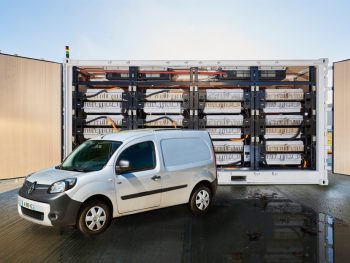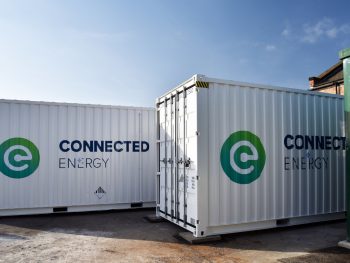Comment: What fleets can learn from Nottingham’s new-era energy eco-system
Connected Energy and Nottingham City Council on how a major new EV charging depot could provide a blueprint for fleets across the country.

The project uses second-life vehicle batteries from Renault Kangoo electric vans
What can fleet managers learn from Nottingham City Council’s innovative EV energy installation and why is its choice of battery storage system so significant?
One of the largest EV fleet charging installations of its kind in the country, described as ‘the perfect marriage between clean energy and transport’, has just been installed in Nottingham for the City Council. It will include 40 vehicle-to-grid bi-directional chargers, and two E-Stor battery energy storage systems supplied by Connected Energy and made from second-life vehicle batteries.
The Eastcroft depot, located just outside the city centre, is home to a fleet of over 200 electric fleet vehicles including six new electric bin lorries, as well as being the main waste disposal depot with an incinerator and recycling on site.
Why is this particular installation of national importance, and what makes it so instructive for other fleet managers?
Fleet managers at thousands of premises across the country will only discover when they come to install EV chargers that their energy supply will be insufficient.
Many others are likely to find that EV charging brings unmanageable peaks in energy demand and cost. Future government legislation will be linked to dynamic grid signals, which will add a further layer of challenge when it comes to installing chargers.
The energy ecosystem at Nottingham’s Eastcroft depot demonstrates how these challenges can be overcome. It is a blueprint for the many fleet managers who will have to deal with extremely difficult or expensive energy problems due to physical supply restrictions or grid constraints, rural energy locations, or legacy buildings if they want to install EV chargers and increase their energy consumption.

The two E-Stor energy storage systems will create a system that can store energy from both the vehicles and solar power
Vehicles as part of the solution
The 40 vehicle-to-grid (V2G) bi-directional chargers will allow the 243-strong fleet to be used as an energy source. The two E-Stor energy storage systems, each made from 24 used Renault vehicle batteries, will create a system that can store energy from both the vehicles and solar power.
EV chargers can put pressure on the grid, and on a site’s energy system where it is near the limit of its capacity, through the sudden peaks or spikes in demand when vehicles are charged.
Because V2G technology allows electric vehicles to both charge and discharge from the grid, they can play a role in dynamic energy management and be part of the solution, rather than the problem. Peaks in demand can be ‘smoothed’ out through energy from the vehicles or from the battery storage, selling demand response services to the grid. The Eastcote depot will make full use of this solution, to achieve both cost and carbon savings.
Heavy-duty support for HGVs
An overarching energy management software solution, developed by Hangar19, will communicate across all the technologies on the site, giving it the flexibility to make the best possible use of its own energy and the ability to smooth out peaks in demand.
Many fleet managers will have vehicles, like the bin lorries at the Nottingham site, which require charging at 80kW and produce energy spikes. They also have complex timetabling requirements to meet operational duties. As Steve Cornes, Nottingham City Council Technical Lead on the project, explains:
“By using intelligently managed battery energy storage and V2G, the use of on-site generated solar energy can be maximised, and the depot will effectively be able to isolate itself from the grid during peak periods and avoid peak tariffs.”
Security and future resilience
As well as energy from the vehicle batteries, the site will have the energy security and independence that comes from its own source for energy from onsite solar PV. The three solar arrays with a combined generation of 176kwp will allow the site to maximise use of renewable energy to decarbonise the charging of the fleet of EVs.
Reducing reliance on the grid is something many sites are looking to achieve, and where energy supply is already at its limit, or grid constrained, this can be one of the only ways to secure more energy. However solar energy is only available in a practical way for fleet managers if it is combined with battery energy storage.
Cost control and forecasting
Cost control is a core issue for every fleet manager. Steve explains the impact this installation will have on its energy bills: “The systems will allow us to ensure production costs of electricity will be negligible, allowing us to peak shave so that we can avoid high electricity tariffs and give us the opportunity to trade electricity back to the grid.”
The energy solution in Nottingham was funded by Interreg NW Europe ‘CleanMobilEnergy (CME)’ with a contribution from Innovate UK, but other organisations can explore the ‘Battery Storage as a Service’ payment route.
Developed to manage costs for solutions like Nottingham’s, this funding approach was developed specifically to take away the need for upfront capital investment and replace it with a monthly controlled fee. All capital and operating costs are wrapped into monthly payments, and users of the service are able to receive grid payments directly. This makes managing costs much simpler.
Nottingham City Council’s ambition is to become the first carbon-neutral city in the country and the project leader has shared his learning.
Steve Cornes’ top tips are:
- Know what your future fleet transition plans are in detail (numbers of EVs/chargers/rapid chargers) and preferably model future requirement scenarios to inform choices (inc. individual vehicle ranges required for operations; operating times – which will give standing times available for charging/opportune charging opportunities and therefore, ability to maximise lower cost energy tariffs, potential use of energy available for V2G arbitrage, diversion to storage etc.).
- Before making any plans, start with an assessment of the current levels of power available on the site in question. Knowing this will give you the foundation to plan for any power upgrades required and/or the mitigation strategies you can use such as smart charging (lowering charger output), and the use of BESS & V2G and help prevent exceeding allocated budgets.
- Don’t forget location – longer cable distances (from the nearest substation) significantly affect costs. These steps will enable you to maximise the number of EVs that can be operated and give a realistic business case that is future-proof, without unexpected costs.
Steve also clarifies the significance of choosing the E-STOR storage systems.
“Our reasons for choosing Connected Energy were two-fold. It was important to us that we found a UK supplier with an emphasis on ongoing maintenance, parts and warranty. The use of second life batteries was also a factor which provides us with a less carbon intensive product.”
Environmental credentials
The use of energy storage systems made from second life batteries is particularly relevant to fleet managers.
Using second-life batteries reduces the demand for new batteries, helping take pressure off the battery supply chain, which helps drive down prices of new EVs, making them more affordable. Having a robust market with strong demand for second life batteries also helps protect the residual value of vehicles, another important factor in fleet economics.












